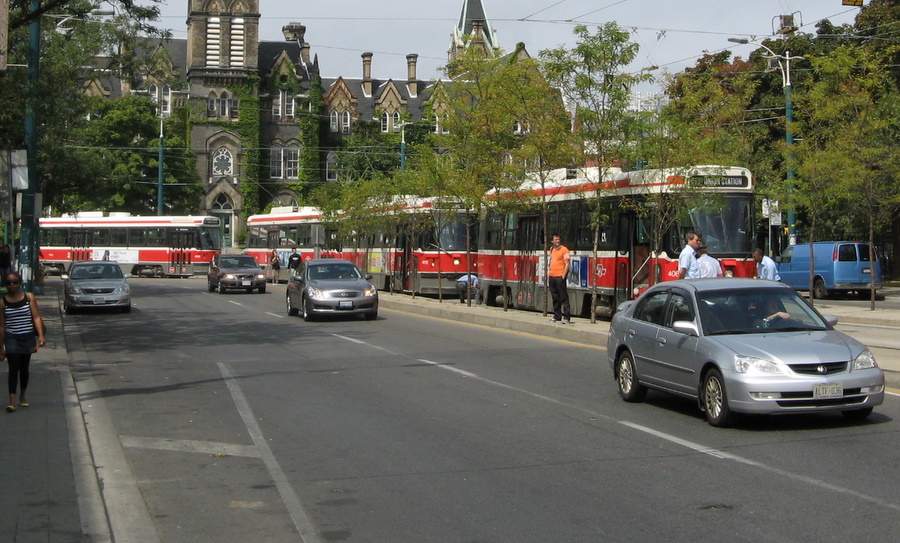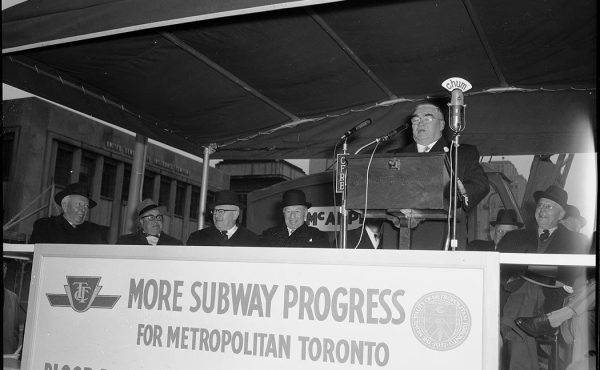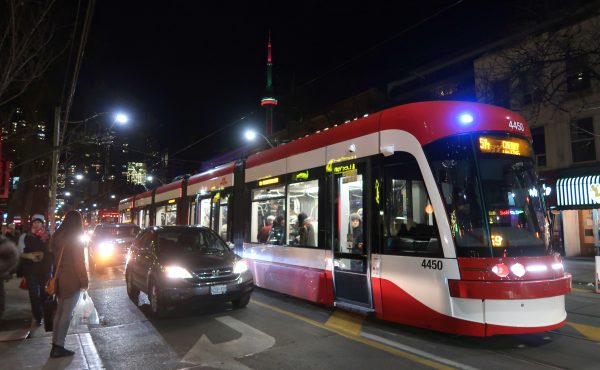
At the Toronto Board of Trade yesterday, Metrolinx Chair Robert Pritchard officially announced the revised timetable for construction of the Transit City LRT lines and the York Region Viva bus-only median lanes. The premise of the speech to the Board of Trade and the accompanying Powerpoint presentation was that things were moving forward just fine, despite grumbling from the City of Toronto and other critics. The name of this revised plan is “Achieving 5 in 10” and the theme of Pritchard’s presentation was “On Track” – each with an emphasis on the claim that all five promised projects would be completed by the end of 2020.
At least now we can see an official, tangible plan for working within the budget and timetable the province has reduced the region to. The rationale is sound, even if they set progress back almost five years. But compared to the optimism of just a few months ago, GTA transit improvements are left waiting on the siding.
The new Metrolinx plan follows the recent provincial budget that severely reduced funding for Transit City and the “VivaNext” projects. Metrolinx was given the unwelcome task of revising the plans already in motion. Some of the slides in the Powerpoint presentation outline the justification for its decisions based on needs and costs.
But as many Spacing readers already know, these claims aren’t entirely true. Phase one of Transit City – Eglinton-Crosstown, Sheppard East, Finch West, and the Scarborough RT replacement – have been cut back; 20 kilometres have been removed from the three new LRT lines, and most individual routes will open years later than scheduled.
The Sheppard East LRT is the least affected of all the projects by virtue of having federal funding and construction underway, even if it is only a railway underpass at the moment. Though the completion date has been delayed by one year to 2015. The new funding plan also cuts the route by one kilometre in the east end, terminating at the planned carhouse at Conlins, instead of Meadowvale Road.
The Finch West LRT (along with the SRT) has been pushed farthest back, and is funded for construction only between Humber College in northern Etobicoke and Keele Street (where it will meet the Spadina Subway extension). Work will not begin until mid-2015 instead of this year, with completion in 2019.
The Eglinton-Crosstown line will begin work late this year (likely detailed engineering plans and preparations), and tunnel boring machines will be ordered this June to start tunneling in 2012. An additional station is proposed to be built underground, most likely at the west end at Jane or Weston Road. But that route will not open until December 2020 (optimistically just under the wire), and only go as far west as Jane Street. This will require a transfer to the airport and into Etobicoke and to the Mississauga Transitway, limiting that line’s impact (though the private rail link will be ready by 2015).
The Scarborough RT replacement – not originally part of the Transit City LRT plans – will not start construction until 2015, after the Pan Am games are over. With aging rolling stock and a problematic propulsion technology, SRT is literally falling apart. The TTC held open houses mere months ago in order for a quick start to construction in order to complete work before the Pan-American games in the Summer of 2015. At those open houses, the TTC had already scaled back plans to extend the route as far as Sheppard and Progress from Malvern Town Centre. It is yet to be determined how the SRT will be kept creaking along until then, but the purchase of second-hand cars from Vancouver’s SkyTrain might be necessary.
York Region’s Viva improvements – busways in the medians of Highway 7 and Yonge Street – have technically started construction (a bus-only road in the “Downtown Markham” development). Of course, the one part of the Viva system that has the greatest need for bus priority measures – Yonge Street between Finch Station and Richmond Hill – isn’t planned as that competes with York Region’s subway dreams. Construction will be phased for completion in 2019.
The Phase II projects under Metrolinx’s plans – the parts of the original three Transit City lines already promised – are unfortunately upushed into a never-never land. The Finch West LRT between Yonge and Keele would have been an important and useful link between the two branches of the Yonge-University-Spadina Subway. Additional transfers will be required at the western end of the Eglinton line and along Finch. One can only guess what will happen to the Jane and Don Mills LRT plans.
Also in limbo are many of the other transit plans across Southern Ontario. Brampton and Mississauga are working on an environmental assessment for LRT for the western GTA’s busiest transit corridor. Hamilton and Kitchener-Waterloo have advanced plans for light rail transit as well. Other necessary – yet unfunded – projects such as a Downtown Relief Line or York Region’s dreams of a Yonge Subway extension are also pushed farther back. The wonderfully ambitious – if somewhat flawed – “Big Move” plan feels out of reach.
The City of Toronto offered to make up the difference in provincial funding as a loan to the province to be paid later in order to complete everything on time. Pritchard echoes the province in rejecting that idea, arguing that borrowing from Toronto is “no different” than debt to “Bay Street or Wall Street.” But Pritchard suggests that Toronto could go ahead and finance on its own the completion of Sheppard East (even as far as UofT-Scarborough) or the Finch West line. Though if that were ever to happen, it would depend on the results on the upcoming municipal election.
Pritchard took shots at both sides of the debate – the ones who prefer subway construction, arguing that the Eglinton and SRT lines are de facto subways, and those who would rethink the plan entirely and delay any progress, as humble as it may be.
I have trouble sharing Pritchard’s optimism, but I am not despondent either. On one hand, this rethought plan is realistic and likely to be (at least mostly) built. But I’ve had my doubts and reservations about aspects of Transit City before, and the new plan amplifies some of these cons, particularly the locations and number of transfers (an additional transfer is now required to cross the top of the city via Finch and Sheppard). But now, I feel that we can only hope that this less ambitious plan is finished on time so we can start dreaming again. Who knows what the political winds could bring next.




10 comments
Better than nothing.
Would still prefer to see them use the original schedule, though. In the future, as we use up the finite oil we have, the governments would wish they could go back.
It’s a little strange that of all places he’d announce this at the Board of Trade. I get that they’re captains of industry and put out a report saying that sitting in traffic on the DVP in your beemer will be bad in the long-run for Toronto’s economy. But why not perhaps bring this to the people in Rexdale or Scarborough who are going to wait even longer now for basic transit? Or those in South Etobicoke or Rouge Hill that will just have to wait for… never now that the line is going to be erased from the future.
Finally – we should elect the metrolinx board directly, all of them. Everyone from Hamilton to Bowmanville from Parkdale to Barrie. None of this unelected Liberal buddies making the calls.
Look, believe it once it’s opened. Just how long has that tunnel under Eglington been sitting there, the legacy of another delay? Look at the bright side: if they built streetcar lines (LRT, my @$$) we’ll never get more subway; if they don’t we’ll get subways once we have total gridlock.
this is like deja vue, they say they will build something, then only build half of it, I could have sworn there was a subway line in northern Toronto that had this happen to it….
My recollection was the Eglinton West hole got filled back in?
I feel that the Sheppard Subway should be converted into an underground LRT. That way, there’s a possibility of a transfer being eliminated.
The extra underground station on Eglinton is Kennedy, not Jane or Weston. When the original plan was tabled it was not clear how the subway/LRT/LRT/LRT/bus/GO interchange would be handled but they are now planning to bring the Eglinton and Scarborough-Malvern LRTs in adjacent to the subway and the Scarborough LRT at concourse level.
In an article in the G&M (linked to in Tuesday’s Headlines), the CEO of Metrolinx says that along Sheppard and Finch, there is not enough density to warrant a subway… yet there is enough density around Jane and Highway 7? With that said, I do understand why the Spadina line is continuing as a subway, to eliminate a ‘useless transfer,’ like that found at Kennedy.
On the topic of useless transfers, the Sheppard stubway is looking to become one. I agree with Transity Cyclist that it should be converted from HRT to LRT to eliminate the potential useless transfer at Don Mills (though with the mall there, it may end up being far less of a useless transfer than Kennedy in which there are no points of interest in the vicinity), and/or continue west to Downsview and operate as a branch of the Spadina line to Vaughan so that it goes somewhere.
One thing I do not agree with in this plan is the lack of priority on the SRT! It is potentially going to be out of service for up to 5 years, if I understand correctly! Converting what we have from ART/ICTS should only take a year, if that, and at a very low cost. Once that is done, any expansion can be done between 2015-2020. Expanding is important, but maintaining what we have is critical.
First, the part of the Eglinton line that was started was filled in back in 1995. There hasn’t been an empty tunne waiting for the futurel. The sad thing is that $300 million 1995 dollars was spent to build nothing. Another Mike Harris legacy. It is possible that the movement of some utilities at that time will aid in the Eglinton construction.
Anyone who thinks that subways are feasible needs to investigate how we will realistically pay for the construction and operating costs. We can’t even get funding to pay for LRTs and the TTC operating budget is always a struggle. I can’t imagine that we could borrow the billions needed since we have been told that the city is nearing it’s borrowing capacity. Tolls might work but could drive people off the expressways to the local streets ironically chokidng the King and Queen streetcar routes. A special property tax could work, but I don’t think that there is support out there for this (even though Toronto property taxes for residents are lower than the 905)
Although I’d love to see subways all over the city, I’m not willing to sacrifice good public transit (albeit truncated public transit) on the alter of something that I can’t imagine happening.
Note that (a) Mr. Pritchard inherited the Sorbara Line and (b) the province and feds worry about density of swing voters (lots in 905, few in 416) not people per se.